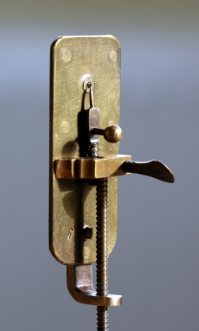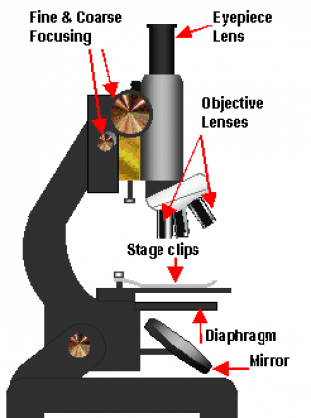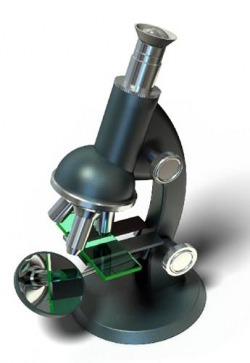First and Early Microscopes of Leeuwenhoek, Seeing Animalcules and Microbiology Begins

Leeuwenhoek' s Microscope, a Replica, not an Original
The Dutch were good at making lenses that worked, and Anton von Leeuwenhoek was able to make and polish lenses that magnified objects about 50x to 200x. None of his microscopes exist today.
Leeuwenhoek's microscopes were simple, hand-held, small, crude microscopes that held objects on the tip of a specimen holder positioned in front of the embedded lens. The replica shown here might have a small hair, fiber or feather attached at the end. Sometimes, a drop of pond water, or fermenting grape juice, or scrapings from the mouth were examined.
Leeuwenhoek was the First Scientist to See and Describe Microbes
He called these new life forms animalcules (little animals), and many different types such as yeasts, bacilli and cocci were described. He gave a detailed written and oral report of his findings to other scientists in 1675. Today, there are much better and bigger microscopes that can see objects as small as 0.2 um.
Leeuwenhoek's microscopes were simple, hand-held, small, crude microscopes that held objects on the tip of a specimen holder positioned in front of the embedded lens. The replica shown here might have a small hair, fiber or feather attached at the end. Sometimes, a drop of pond water, or fermenting grape juice, or scrapings from the mouth were examined.
Leeuwenhoek was the First Scientist to See and Describe Microbes
He called these new life forms animalcules (little animals), and many different types such as yeasts, bacilli and cocci were described. He gave a detailed written and oral report of his findings to other scientists in 1675. Today, there are much better and bigger microscopes that can see objects as small as 0.2 um.
Simple, Modern, Light Microscopes –2 Lenses, Light Source, Condensor, Iris Diaphragm

Microscope, A Simple, Good, Model; (Image, T. Knott)
Standard, Simple Microscopes — Functions and Parts
These microscopes have 2 to 4 objective lenses with magnification powers of 10x, 20x, 45x and 100x as typical lens values. These lenses are parts of the microscope that can be rotated in a circular pattern and locked into place one at a time as needed. The lowest power of objective lens is first used. Then, when proper focus is obtained and observations are made, the next higher power can be rotated into position. The 100x objective is an oil immersion lens and a part of the microscope that requires special immersion oil to create an interface with the lens, and this forms a unified lens-oil combination.
The fine and coarse focusing knobs are those parts of the microscope enable the scientist to obtain a clear view of the object on the slide which rests on the stage. The slide is held in position by stage clips. The eyepiece (ocular) lens has a fixed position relative to the objective lenses. These parts all are important to enable the microscope to be used and function well.
Total Microscopic Magnification Power
Magnification power is calculated by multiplying the eyepiece value (10x) times the power of each objective lens; therefore, 100x, 200x, 450x and 1000x total magnifications usually can be obtained. Therefore, the objective lens and eyepiece lens values that are inscribed on each lens, permit the scientist to figure the final full magnifying power of the combination being used.
Microscope Resolution is Important
Although high magnification is desirable, good resolution is always needed (ability to see separation between 2 parallel lines) and is always important. Think as follows — if something is big and blurry, compared to something that is smaller and real clear, which is the preferred image?
The best light microscopes can resolve at 0.2 um (micrometers = 1 millionth of a meter). This is the limit of resolution of the light microscope which is 1/2 wavelength of the light used. If blue light (see spectrum at the beginning of this page) is used, then blue at 400 nm (nanometers) = 4000 A (Angstroms) = 0.4 um, and the resolution = 1/2 of 0.4 um = 0.2 um.
These microscopes have 2 to 4 objective lenses with magnification powers of 10x, 20x, 45x and 100x as typical lens values. These lenses are parts of the microscope that can be rotated in a circular pattern and locked into place one at a time as needed. The lowest power of objective lens is first used. Then, when proper focus is obtained and observations are made, the next higher power can be rotated into position. The 100x objective is an oil immersion lens and a part of the microscope that requires special immersion oil to create an interface with the lens, and this forms a unified lens-oil combination.
The fine and coarse focusing knobs are those parts of the microscope enable the scientist to obtain a clear view of the object on the slide which rests on the stage. The slide is held in position by stage clips. The eyepiece (ocular) lens has a fixed position relative to the objective lenses. These parts all are important to enable the microscope to be used and function well.
Total Microscopic Magnification Power
Magnification power is calculated by multiplying the eyepiece value (10x) times the power of each objective lens; therefore, 100x, 200x, 450x and 1000x total magnifications usually can be obtained. Therefore, the objective lens and eyepiece lens values that are inscribed on each lens, permit the scientist to figure the final full magnifying power of the combination being used.
Microscope Resolution is Important
Although high magnification is desirable, good resolution is always needed (ability to see separation between 2 parallel lines) and is always important. Think as follows — if something is big and blurry, compared to something that is smaller and real clear, which is the preferred image?
The best light microscopes can resolve at 0.2 um (micrometers = 1 millionth of a meter). This is the limit of resolution of the light microscope which is 1/2 wavelength of the light used. If blue light (see spectrum at the beginning of this page) is used, then blue at 400 nm (nanometers) = 4000 A (Angstroms) = 0.4 um, and the resolution = 1/2 of 0.4 um = 0.2 um.
Student Microscopes – How to Choose and Obtain a Quality Beginner's Microscope

Microscope, Quality Optics Matter
A student or home microscope is a wonderful teaching and research instrument. A simple microscope takes the student way beyond simple magnifiers and magnifying glasses. There is a difference between 10x and 100x or 400x magnifications.
Because the microscope is an important purchase, anyone contemplating purchasing a microscope needs to keep in mind that optics are the most critical parts of the microscope. Without good optics, the microscope is not an effective instrument, and the expenditure is not worthwhile. A microscope may look good, and have flashy and good-looking parts, but if the optics are not quality glass, that microscope is not worth purchasing.
Buying a Microscope – Some Basic Questions to Ask When Considering a Purchase
Does the microscope have
1. glass optics or plastic optics? Glass optics are necessary.
2. manufacturer, seller, or reviewers who actually state that these are good optics?
3. a stable body, that is of well-machined and substantial, enduring quality?
4. a guarantee, that is a satisfaction guaranteed by a return policy?
5. good customer reviews that support quality and goodness?
5. some basic slides and accessories included, lens paper?
Review and study these points about the optics and other parts of a microscope before purchasing one.
VISIT Our Science Super School Store
All the Written Material within Site is Copyrighted 2010 and Owned by Dr. Donald Reinhardt, and this original material is protected legally by this copyright notice and by the Digital Millennium Act. None of this original material may be copied or reproduced without the expressed written consent of the author.
The author is a Freelance Science writer, and is available for specific assignments for those who are interested – by contacting adminstrator@sciencesuperchool.com. Other questions related to this teaching site should be directed to teacher@sciencesuperschool.com.
Because the microscope is an important purchase, anyone contemplating purchasing a microscope needs to keep in mind that optics are the most critical parts of the microscope. Without good optics, the microscope is not an effective instrument, and the expenditure is not worthwhile. A microscope may look good, and have flashy and good-looking parts, but if the optics are not quality glass, that microscope is not worth purchasing.
Buying a Microscope – Some Basic Questions to Ask When Considering a Purchase
Does the microscope have
1. glass optics or plastic optics? Glass optics are necessary.
2. manufacturer, seller, or reviewers who actually state that these are good optics?
3. a stable body, that is of well-machined and substantial, enduring quality?
4. a guarantee, that is a satisfaction guaranteed by a return policy?
5. good customer reviews that support quality and goodness?
5. some basic slides and accessories included, lens paper?
Review and study these points about the optics and other parts of a microscope before purchasing one.
VISIT Our Science Super School Store
All the Written Material within Site is Copyrighted 2010 and Owned by Dr. Donald Reinhardt, and this original material is protected legally by this copyright notice and by the Digital Millennium Act. None of this original material may be copied or reproduced without the expressed written consent of the author.
The author is a Freelance Science writer, and is available for specific assignments for those who are interested – by contacting adminstrator@sciencesuperchool.com. Other questions related to this teaching site should be directed to teacher@sciencesuperschool.com.